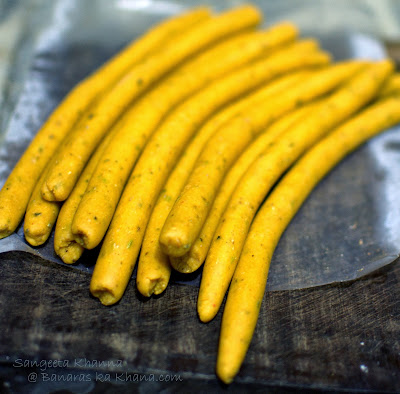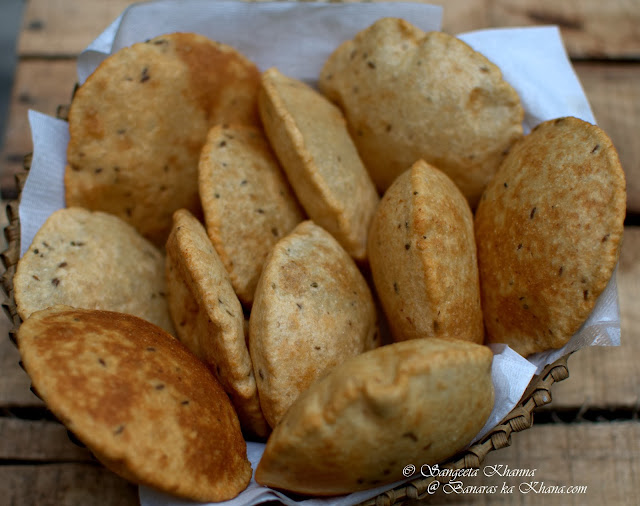There are so many rice varieties in India that talking about Basmati only is sacrilege. We have short grain fragrant varieties of rice found in the eastern part of India and katarani, jeera batti, kala namak, gobind bhog, badsha bhog etc are the preferred rice varieties with any light seasonal curries and daals that make staple food in this part of the world. We even make our pulaos and tahiris using these fragrant short grain rice. Basmati is used only for the biryanis and some pulaos and that is just for the looks of it. Fragrance of jeera batti and gobind bhog is way superior than basmati.
But today I am talking about the coarse rice varieties. These are not fragrant by any means but they do have a distinct aroma of their own. We have so many of the coarse rice varieties, each one different in it's taste and nutrient profile. The stickier the rice cooks, the more fragrant it is, and the nutrient profile is also better being richer in proteins, fiber and zinc apart from some other minerals and vitamins. I found two varieties of sticky rice from Meghalaya, one is a deep pink when cooked and another is deep purple when cooked and both taste so good I don't have words to explain. More on that later.
A rice variety called saathi has been making me curious for a long time as I had tasted laddus made with this in my childhood and my grandmother and father both used to say how good the taste is when saathi rice is cooked for hot meals. I had always wanted to have saathi ke chawal for a regular daal chawal meal so I can understand what they meant.
And then I saw saathi rice in a small village shop when we visited our ancestral village 2 months back, and bought a couple of kilos immediately. Papa was so happy once again to see how interested I am in such forgotten grains. Later I wrote an article for Down to Earth magazine later which you can see here. The same article I am posting here without any edits.
There are many rice varieties which are on the verge of getting lost forever. Saathi rice is one of those varieties that is coarse, pink streaked rice with a mild sweet taste when cooked. The rice releases so much starch when cooked that the cooked rice looks like a pink lumpy porridge when the rice is new, aged rice cooks to more separate grains though.
I had my first tasting of saathi ke chawal with peeli daal and alu hare pyaz ki bhujia. Here is how it looks when cooked. I loved this simple meal absolutely, I feel blessed when I can eat what my ancestors might have eaten.
Saathi ke chawal was once a staple rice being cooked in many homes in eastern part of India. I am told that rich families could afford the fragrant short grain rice but still there were a few religious rituals around festivals when this saathi rice was used. How well our ancestors knew how to preserve such grains from being lost.
This rice variety gets ready in 60 days (saath din) and hence the name saathi. It is an early variety which can be sown on the onset of monsoons and gets ready till the heavy monsoons last in the plains, giving way to late rabi crops in the last leg of monsoons. Saathi is known to thrive in waterlogged lowlands, so the wastelands of villages where nothing can be grown due to water logging, sathi is the best option. This cultivar of rice is marked by short strong stems, ear (panicle) partially closed in the sheath and the grain husk dark coloured. It is a low yielding variety which is suitable for broadcast method of sowing. This cultivar of rice is mentioned in Ain-e-Akbari as a low class rice. I figure saathi rice brought lesser revenues for the state, being cheaper food for the poor.
Luckily, saathi is associated with some festive rituals and people grow and stock it for the same reason. Another example of how religious rituals help preserve a native variety. A kheer made with cane sugar and saathi, called Rasiya or Rasiayao (that means, cooked is ras or sugarcane juice), is used during chath pooja in Bihar. Saathi laddus are made during wedding rituals in Eastern UP and Bihar as well.
Saathi rice is considered to be easily digestible and nourishing in rural areas. Different preparations are made to make it suitable for different requirements. A dish called Maheri is made with overcooked saathi rice and buttermilk with salt, green chillies, ginger etc, almost like a thin curd rice, considered good for liver disorders and indigestion.
A laddu made along with ginger powder and fried edible gum and nuts is considered good for winter months, especially for joint related ailments.
Cooked saathi rice can be had with daal and subzi as a normal daal-rice meal, to take the benefits of low glycemic index of this coarse rice cultivar. Saathi is definitely rich in minerals, apart from several amino acids but there is no detailed study on its nutrient profile.
Recipe of saathi ke laddu
Ingredients
Saathi rice 250 gm
Almonds (preferably gurbandi variety) 200 gm
Flax seeds 100 gm
Grated fresh coconut 50 gm or to taste
Golden raisins 80 gm or to taste
Raw sugar or grated jaggery 250 gm or to taste
Ghee 200 gm
Method
Rinse the rice well several times, drain and keep in a wide strainer for an hour or till the surface gets dry but the grain becomes a little soaked.
Powder the partially soaked rice in a mixie jar or coffee grinder. This powder is to be used immediately as it cannot be stored at room temperature.
Heat ghee in a wide pan and add the powdered rice and bhuno it on low flame till light brown and aromatic.
Powder the almonds and flax seeds coarsely, dry roast the grated coconut and chop the raisins.
Mix everything to the roasted rice flour, mix well and make laddus of desired size while the mixture is still a little warm in winters, otherwise the ghee gets harder to bind.
I sometimes keep the laddu mixture loose and have it like a loose granola mix or mixed with hot milk to be had like a porridge. Makes complete sense in modern times.
We need to revive our ancient grains. Isn't it?










































































